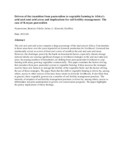| dc.contributor.author | Nyamwamu, Beatrice | |
| dc.contributor.author | Okello, Julius, J. | |
| dc.contributor.author | Kironchi, Geoffrey | |
| dc.date.accessioned | 2013-03-14T07:02:48Z | |
| dc.date.issued | 2012-04 | |
| dc.identifier.citation | African Journal of Agricultural Research Vol. 7(15), pp. 2273-2282, 19 April, 2012 | en |
| dc.identifier.issn | 1991-637X | |
| dc.identifier.issn | http://www.academicjournals.org/AJar/abstracts/abstracts/abstract2012/19%20Apr/Nyamwamu%20et%20al.htm | |
| dc.identifier.uri | http://erepository.uonbi.ac.ke:8080/xmlui/handle/123456789/13680 | |
| dc.description | Journal article | en |
| dc.description.abstract | The arid and semi arid areas comprise a large percentage of the land area in Africa. Communities in
these areas have over the years depended on livestock production for livelihood. Livestock has
traditionally served as source of food and a store of wealth in the arid and semi arid areas. However, the
challenges posed by the harsh environmental factors, especially climate-change induced shocks are
causing significant changes in livelihood strategies in the arid and semi-arid areas. Increasing numbers
of households are shifting from pure pastoralist livelihood to crop farming with many growing
vegetables commercially. This paper examines the factors driving this transition from pure pastoralist
system to vegetable farming. It then assesses the strategies used by these new farmers to manage the
fertility of the vegetable fields and the factors driving the use of these strategies. The paper finds that
the shift to vegetable farming is driven by, among others, access to other sources of income, hence
desire to diversify livelihoods. It also finds that, in general, these vegetable growers use a number of
soil fertility management practices. The intensity of adoption of soil fertility management practices is
driven by, among others, access to information and prior participation in govern soil conservation
programs. The paper highlights the policy implications of these findings. | en |
| dc.publisher | Academic Journals | en |
| dc.subject | Kenya | en |
| dc.subject | Pastoralists | en |
| dc.subject | Transition | en |
| dc.subject | Vegetable farming | en |
| dc.subject | Fertility management | en |
| dc.subject | Drylands | en |
| dc.title | Drivers of the transition from pastoralism to vegetable farming in Africa’s arid and semi arid areas and implications for soil fertility management: The case of Kenyan pastoralists | en |
| local.publisher | Department of Agricultural Economics | en |
| local.publisher | Department of Land Resource Management and Agricultural Technology, | en |

